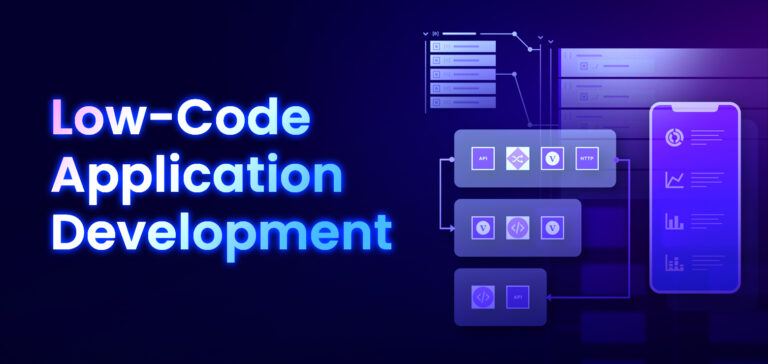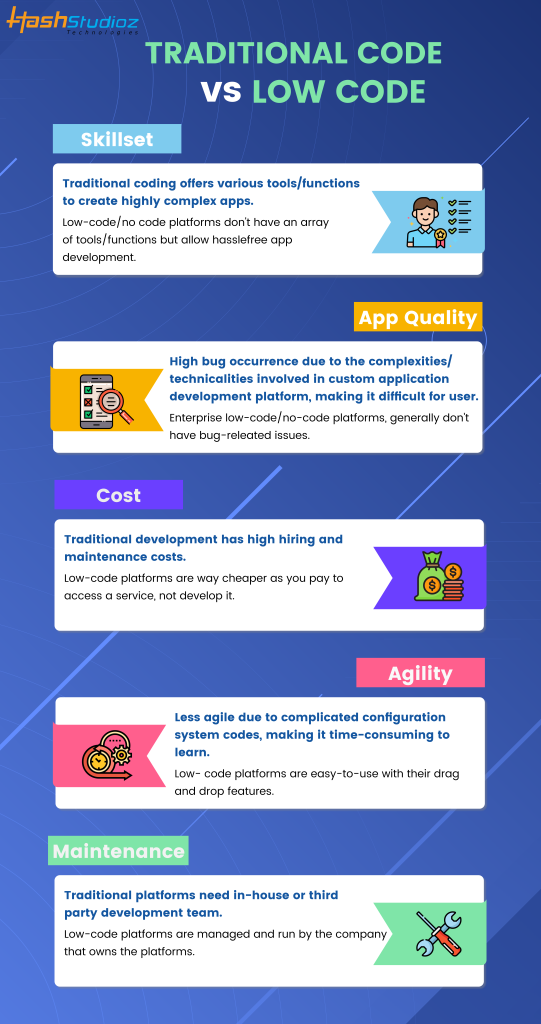Recommended Ideas On Deciding On Legacy application modernization with Low-code
Wiki Article
Benefits Of Low-Code Application Development In Terms Of Accessibility To Non-Developers
Low-code app development improves accessibility by non-developers (often called "citizen-developers") due to a few key factors.
Drag-and Drop Builders: Low-code platforms include drag-and-drop interfaces, which allow non-developers develop applications without needing to write code. This makes it simpler for people who don't have technical expertise to be involved in the process of development.
WYSIWYG Editors: "What You See Is What You get" editors let users create interfaces and workflows in a manner that closely resembles the final product, making it much easier to understand and use.
Simple Logic and Workflow
Visual Workflow Design: Users are able to easily create business processes and application logic with diagrams, models, and flowcharts. They are easier to implement than traditional coding.
Pre-built Logical Components: A lot of low-code platforms come with already-built logic components (e.g. conditions, loops), that are easily configurable. This eliminates the need to code complex programs.
Templates and components that can be reused:
Libraries of prebuilt templates Low-code platforms usually offer libraries of templates for the most popular types of applications. This gives non-developers the ability to begin with a solid basis and customize it as required.
Reusable modules and widgets by using modular or reusable widgets users can streamline the process of creating them by eliminating the need for extensive technical expertise.
Tutorials for Guided Development and Guided Development:
Step-by-Step Guides: Platforms usually provide a development path that is guided as well as tutorials and on-screen guidelines to assist novice developers in building applications.
Interactive Tutorials. Interactive, hands on tutorials let users learn by doing.
Integration of existing tools:
Easy integration: Low-code platforms have been developed to integrate seamlessly with existing business systems and tools (e.g. CRM, ERP) allowing non-developers create applications within their current workflows.
APIs/Connectors: The APIs/Connectors built-in allow non-developers to connect their apps to external services.
Collaboration Features:
Team Collaboration Real-time collaboration, shared workspaces and shared workspaces permit non-developers, business analysts and other users to efficiently work with professional developers.
Role Based Access Control: You can assign non-developers specific roles with the appropriate access level so that they can be part of the development process without hindering security or the functionality.
Automated Tests and Debugging
Built-In Testing Tools: Low-code platforms typically include built-in testing and debugging tools to automate these procedures, making it much easier for non-developers to ensure their applications work correctly.
Error Highlighting - When problems occur, the platform identifies problems and provides solutions, while guiding users through the process of troubleshooting.
The general rule is that low-code development has the ability to open up development to a wider audience. This is a major advantage for non-developers. Low-code platforms are easy to use visual tools, guiding user experiences, and allow business users to actively participate in developing apps, maintaining them and updating them. View the best her latest blog for website advice including developing mobile apps, app development platform, stored sql procedures, mobile development platforms, cross platform mobile app development, cross platform app development, cross platform mobile development, rad application development, build a docker container, database in azure and more.

Flexibility And Scalability Are The Two Major Benefits Of Low-Code Application Development
Low-code development offers numerous advantages in terms of scalability and flexibility, which is crucial to developing applications that can be able to grow and adapt with changing business requirements. These are the most significant advantages:
Cloud-based deployment. Many low-code platforms have cloud-based deployments, which allows users to easily scale their applications using cloud infrastructure. This allows businesses handle increased workload without having to manage servers.
Auto-Scaling Features: Built-in auto-scaling features can automatically adjust resources in response to demand, which ensures constant performance during peak times without any manual intervention.
Flexible Architecture:
Modular Design: Low-code platforms encourage the modular design of applications, which allows components to be developed independently and tested, as well as scalable. This flexibility increases flexibility and allows to expand or update specific elements of an application without impacting the whole system.
Microservices Integrate: They allow applications to expand and be flexible because they can be constructed as a group of loosely connected services.
Customizable Options:
Extensibility: Low-code platforms usually allow for customization of scripts and codes which allows developers to extend the capabilities of their applications beyond what is available in the box. It allows developers to meet their own business needs without restrictions.
Third-Party Integrations: Integration with third-party APIs and services allows businesses to add additional functions to their applications.
Agile Development and its deployment:
Continuous Delivery and Deployment Low-code platforms can be used to implement agile methods, enabling continuous integration and continuous delivery (CI/CD). This facilitates rapid release of updates and features. Applications are then able to evolve rapidly as a result of market trends and user feedback.
Iterative development low-code development is an iterative process, which means applications can be scaled up and developed gradually. This minimizes the chance of large-scale changes while allowing an controlled growth.
Resource Optimization
Low-code platforms offer tools to track and manage the performance of an application and help to optimize the use of resources. This helps ensure that resources are used efficiently. They are also able to be scaled-up or down according to actual needs.
Load Balance: This feature lets the application manage massive traffic by distributing workloads over several servers. This also ensures performance is consistent.
Global Reach
Multi-Region deployment: Low-code applications typically allow deployment across multiple regions. This enables businesses to provide low-latency services to users around the world. This is particularly important when applications are popular with a worldwide user base.
Localization Support. The built-in ability to localize applications allows them to be easily modified to other languages, regional demands and enhances their flexibility across different markets.
Maintenance and Updates:
Simple Maintenance : Low-code applications' visual and modular nature simplify maintenance tasks. This lets updates and bug fixes be made quickly, with no lengthy downtime.
Version Control: The integrated version control system helps control changes and roll backs. This makes sure that updates can be easily deployed and previous versions restored when needed.
Cost Efficiency:
Low development costs. By reducing coding requirements, low-code platforms lower the development cost and allow applications to be scaled up without increasing the development effort.
Pay-As-You Go Models - Many low-code platforms have flexible pricing models, such as pay-as you-go that is based on the actual usage, growth, as well as financial flexibility.
In general, low-code development provides businesses with the flexibility and scalability that they require to develop robust and flexible apps. These platforms allow quick adjustments to evolving requirements as well as efficient utilization of resources and continuous advancement. This ensures that applications can evolve with the needs of the business. Read the most popular Legacy application modernization with Low-code advice for website info including application modernisation, app modernization, low code platforms, mobile app development platforms, push alerts, low code development platforms, developing mobile apps, push notifications android, low code development platforms, rapid action development and more.

Advantages Of Low-Code Application Development In Terms Of Vendor Support And Community
Low-code applications development platforms are a great method to gain vendor support and community involvement. Both of these factors are essential to ensure a successful implementation and ongoing maintenance of the app. These are the main benefits: Support
Comprehensive Technical Support:
Support Teams with Dedicated Support Many low-code platforms offer dedicated support teams that can help in technical problems, problem-solving and advice. This ensures that any issues are swiftly addressed.
Support is available 24/7: Many vendors provide around-the-clock assistance which is particularly beneficial for companies that operate in different time zones.
Training and Onboarding
Vendors offer structured learning programs such as webinars, tutorials and certifications to help users get familiar with the system.
Personalized Onboarding Many vendors offer individualized services to assist their new customers get onboard efficiently and adapt it to their specific needs.
Regular updates and improvements:
Continuous Improvement Lowcode platform providers typically issue regular updates that include new features, performance enhancements and security patches. This helps to ensure that the platform is up-to-date and safe.
Feedback integration: Vendors often incorporate user feedback into their development cycle to ensure that their platform is able to meet the changing demands of their users.
Comprehensive Documentation:
Detailed Documentation: Extensive and well-organized documents are usually available that covers everything from basic usage to advanced customization. This allows users to solve problems independently.
API References: API documentation is detailed and aids developers in integrating APIs with other platforms, and to further modify their applications.
Professional Consulting Services
Expert Consultation. Vendors offer a range of consulting services including architecture design as well as strategic planning, and even complex platform implementations. These services ensure users get the most out of their platform.
Custom Development Services A few vendors offer customized development services to create specific integrations and features that aren't available in the standard.
Community Support
Active User Groups:
Discussion boards and forums Forums and discussion boards: A lot of low code platforms have vibrant online communities that allow users to inquire about issues, exchange ideas and work together on best practices.
Local and virtual User Groups as well as Meetups, provide opportunities for users to exchange experiences, share their knowledge with others, and build relationships.
Collaboration and Knowledge Sharing:
Community-Contributed Resources: Users often share templates, modules, and extensions that they have developed, which can be reused or adapted by others, accelerating development and innovation.
Crowdsourced Solution Finding: The collective experience and wisdom of a group could be an excellent resource for solving complex issues.
Learning and Development
Community-led Training: A lot of groups hold workshops, training sessions and webinars. These are usually led by experienced users, who provide practical advice and advanced techniques.
Online Tutorials: Members of the community make and share a variety of online tutorials, how-tos, and tutorials. These tutorials are made available to everyone.
Feedback and Influence
Product Feedback Channels: Community forums typically include channels for providing feedback to the vendor which may influence the development of new features and enhancements.
Beta Testing Programmes Members of the community who are active could get the chance to take part in beta programs. This gives them the first glimpse of new features and also a a chance to help shape the platform’s evolution.
Recognition and Support
Community Recognition Programs - Many companies offer recognition programs that acknowledge the contributions made by active members of their community such as MVP (Most Valuable Professionals) programs.
Peer Support: Members of the community frequently provide support to peers offering their expertise and offering guidance to users who are not as familiar, fostering a collaborative and positive environment.
The overall result of a strong vendor support and active, engaged communities provide a complete environment for the support for low-code application development. The combination of robust vendor support and a vibrant and engaged community creates an entire support network for development of low-code applications.
